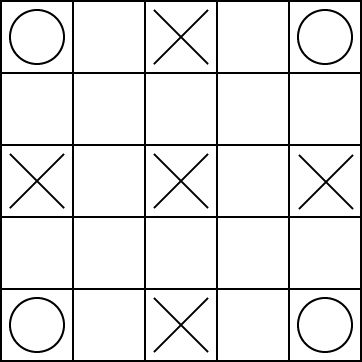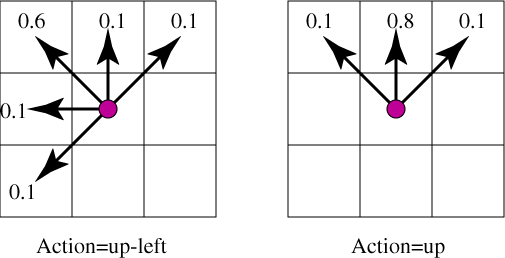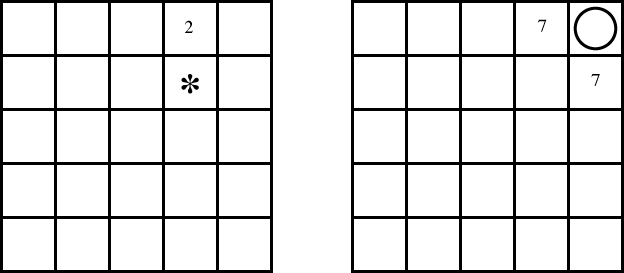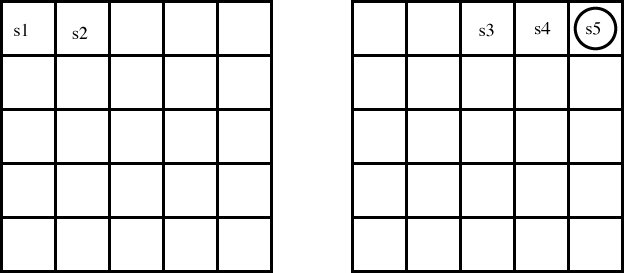CPSC 502 -- Fall 2006
Non-Assignment 5
- Give the feature-based representation of the MW and RHM
features.
- Give the STRIPs representations for the pickup mail, and the
deliver mail actions.
- What are the errors on lecture 11.2, page 4?
- What are the errors on lecture 11.3, page 5?
- Suppose the robot cannot carry both coffee and mail at the same
time. Give two different ways that the CSP that represents the
planning problem can be changed to reflect this. Test it, by giving
a problem where the answer is different when the robot has this
limitation than when it doesn't.
These questions are available from the textbook available on the
course WebCT site.
- Do exercise 12.2
- Do exercise 12.4
- Do exercise 12.5
- Suppose our Q-learning agent, with fixed alpha (alpha), and
discount gamma (gamma),
was in state 34 did action 7, received reward 3 and ended up in state
65. What value(s) get updated? Give an expression for the new
value. (You need to be as specific as possible)
- In temporal difference learning (e.q. Q-learning), to get the average of a sequence of k values, we let
alpha = 1/k. Explain why it may be advantageous to keep alpha fixed in
the context of reinforcement learning.
- Suppose someone suggested using alphak=10.0/(9.0+k).
Explain why it is of this form (e.g., why 9+k on the bottom?)
Would you expect it to work well? Explain.
- Explain what happens in reinforcement learning if the agent always
chooses the action that maximizes the Q-value. Suggest two ways that
can force the agent to explore.
- In MDPs and reinforcement learning explain why we often use
discounting of future rewards. How would an agent act differently if
the discount factor was 0.6 as opposed to 0.9.
- What is the main difference between asynchronous value iteration and
standard value iteration?
Why does asynchronous value iteration often work better than standard
value iteration?
- What is the relationship between asynchronous value iteration and
Q-learning?
Consider the game domain:

There are monsters at the squares marked with an X. Each monster
randomly and independently, at each time,
checks if the robot is on their square. If
the robot is on the square when the monster checks, it has a
reward of -10 (i.e., it loses 10 points). At the centre point the
monster checks at each time with probability p2=0.4, at the other 4
squares marked with an X, the monsters check at each time with
probability p3=0.2.
The robot has 8 actions corresponding to the 8 neighbouring
squares. The diagonal moves are noisy; there is a p4=0.6 probability of going
in the direction chosen and an equal chance of going to each of the 4
neighboring squares that are closest to the desired direction. The
vertical and horizontal moves are also noisy; there is a probability
p5=0.8 chance of going in the requested direction and an equal chance
of going to one on the adjacent diagonal squares.
For example, the actions up-left and up have the following result:
If the action would result in crashing in a wall, the robot has a
reward of -2 (i.e., loses 2) and does not move.
There is a discount factor of p6=0.9.
Assume that the rewards are immediate on entering a state (i.e.,
if the robot enters a state where there is a monster, it gets the
(negative) reward on entering the state, and if the robot enters the state
where there is a treasure it gets the reward on entering the state,
even if the treasure arrives at the same time).
Suppose we are using the inefficient state space representation with
125 states.
Suppose we are running value iteration, and have the
following values for each state: [The numbers in the square represent the value of that state, and where empty squares have a zero value. It is irrelevant to this question how these values got there]:
where the treasure is at the circle. There are also states for the treasures at the other four corners.
Consider the next step of value iteration. For state s13, which
is marked by * in the above figure, and the action a2 which is
"up", what value is assigned to Q[s13,a2] on the next
iteration of value iteration? You need to show all working, but don't
need to do any arithmetic (i.e., leave it as an expression). Explain
each terms in your expression.
Consider the same domain, but where the agent isn't given a model.
Suppose that the agent steps through the state space in the order of steps given in the diagram below, (i.e., going from s1 to s2 to s3 to s4 to s5), each time doing a "right" action.
Note that in this figure, the numbers represent the order that the robot visited the states. You can assume that this is the first time the robot has visited any of these states.
- Suppose a monster did not appear at any time during any of these experiences. What Q-values are updated during Q-learning based on this experience? Explain what values they get assigned. You should assume that alphak=1/k.
- Suppose that, at some later time, the robot revisits
the same states: s1 to s2 to s3 to s4 to s5, and hasn't visited any of these
states in between (i.e, this is the second time visiting any of these states). Suppose this time, the monster appears
so that the robot gets a penalty. What Q-values have their values
changed? What are their new values?
David Poole




